
If you’re in the business of providing unforgettable travel experiences, email can be an ideal communication channel for building relationships with potential customers.
But where do you start?
How do you create effective email campaigns that will capture your customers’ attention and drive bookings?
In this guide, we’ll cover everything you need to know about email marketing, from the basics of building an email list to choosing the best software provider and measuring your success. With this guide, you’ll have the tools needed to take your email marketing to the next level and grow your business.
What are the benefits of email marketing for tour operators?
Tour operators and attractions can leverage email marketing to strengthen the relationship with their past, current, and future customers, making it an essential piece of their overall marketing strategies. Building an email list can help you in many ways, including:
- You can communicate with customers directly. This is especially important if your customers have booked through a third-party platform. By collecting every customer’s email, you’ll be able to communicate with them directly rather than going through another service provider or agency.
- You can keep the conversation going. This means you can keep customers engaged even after their visit. You can share exciting news, tour updates, and special promotions to keep your brand top of mind.
- Email marketing helps drive customer loyalty. With every email, your customers will become more familiar with your brand. A great way to turn that familiarity into loyalty is to offer special discounts to past customers. For example, a 10% discount off a second tour booking.
- It makes it easier to collect customer feedback. The best time to ask for customer feedback is immediately after their visit so the experience is still fresh in their minds. Sending an email with a link to your preferred review website is a great way to increase your reviews online.
- The right email campaign can help increase leads. Anyone can sign up for your email list through your website, even those who haven’t booked a tour. In that case, you can nurture them with a promotional campaign and eventually convert them into customers.
Choosing an email marketing platform
Email marketing platforms allow you to create and manage your email list and campaigns. These platforms typically offer a range of features to help you design, send, and track your emails, including email templates, automation, and integrations with other marketing tools.
What to consider when evaluating different email marketing software options
- Look for the features that meet your tour company’s needs: A few features to look for include email templates, automation workflows, list management, segmentation, reporting and analytics, and integration with other tools.
- Ease of use: Make sure the software is user-friendly and easy to navigate. Avoid investing in software that is difficult to use and requires too much training to master.
- Pricing: Compare the different pricing models offered by the top software providers. Some may charge a monthly subscription fee, while others may charge based on the number of subscribers or emails sent.
- Customer support: Look for software options that offer robust customer support, including email and phone support. Online resources like tutorials and knowledge-based articles are also helpful.
- Integration: Check if the software can integrate with other tools and services you use in your business, such as your CRM or social media platforms.
- Security and compliance: Ensure that the software adheres to industry standards for security and compliance, including GDPR, CCPA, and CAN-SPAM regulations.
Most popular email marketing software for tour operators
You can start by learning more about the six of the best email marketing platforms for tour operators and attractions.
1. MailChimp
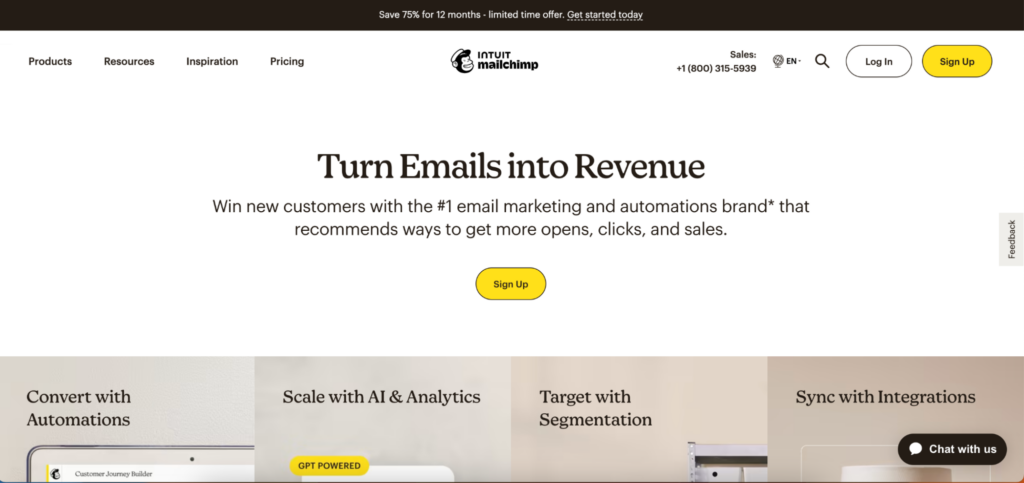
MailChimp is a popular email marketing tool for small businesses. Some key features include an easy-to-use drag-and-drop email builder, list segmentation, automations, and detailed reporting and analytics.
For tour operators, MailChimp’s integration with various e-commerce platforms like Shopify and WooCommerce can help generate revenue through your email campaigns. Its free plan is a great option for smaller tour operators who are just getting started with email marketing.
Pricing: Mailchimp offers a free version, with more advanced plans starting at $3 per month.
Pros of using Mailchimp:
- Mailchimp has a user-friendly interface, making it easy for users of skill levels to use its features effectively. The platform promises a smooth and seamless user experience.
- It provides a comprehensive set of features beyond basic email marketing, including audience segmentation, automation, landing page creation, social media advertising, postcard campaigns, and more.
- The platform is a great tool for businesses of all sizes, from small startups to large enterprises. It can accommodate a growing subscriber base, increasing campaign volume, and evolving marketing needs.
2. Constant Contact
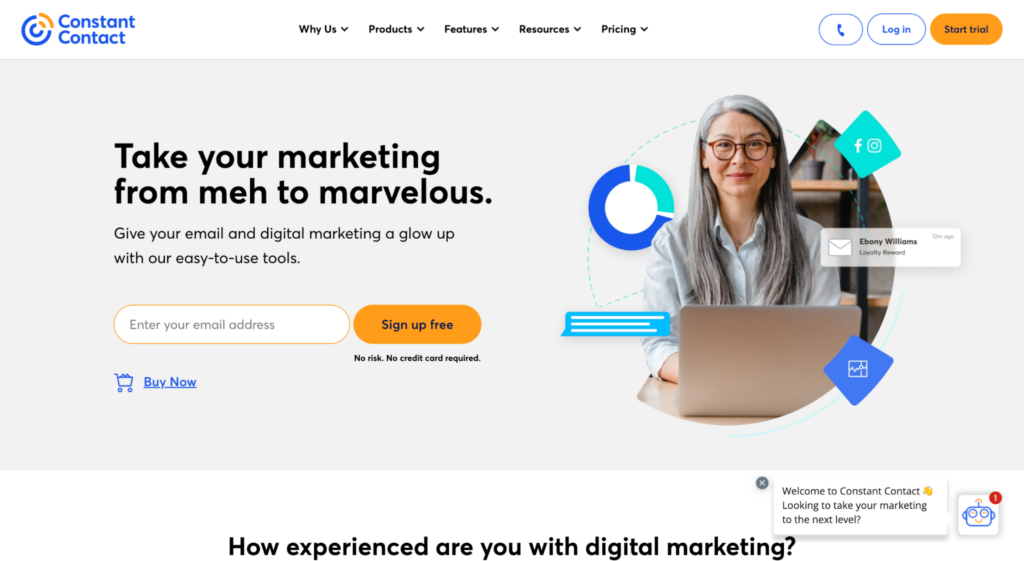
Constant Contact is another popular email marketing platform that offers a user-friendly interface and a wide range of features. You’ll have access to professionally-designed email templates, automation workflows, customer list management, and in-depth reports. Constant Contact’s event management features — including event promotion and RSVPs — can be particularly valuable for tour operators, allowing you to quickly sell tours or excursions.
Pricing: Plans start at $12 per month.
Pros of using Constant Contact:
- Constant Contact focuses on serving small businesses. Its user-friendly features, customizable templates, and educational resources can be ideal for small tour or attraction operators.
- Its event management features ake it easy for you to create and promote events, track registrations, and send event-related emails.
- There is a wide selection of professionally designed email templates, allowing you to customize each to your brand identity.
3. AWeber
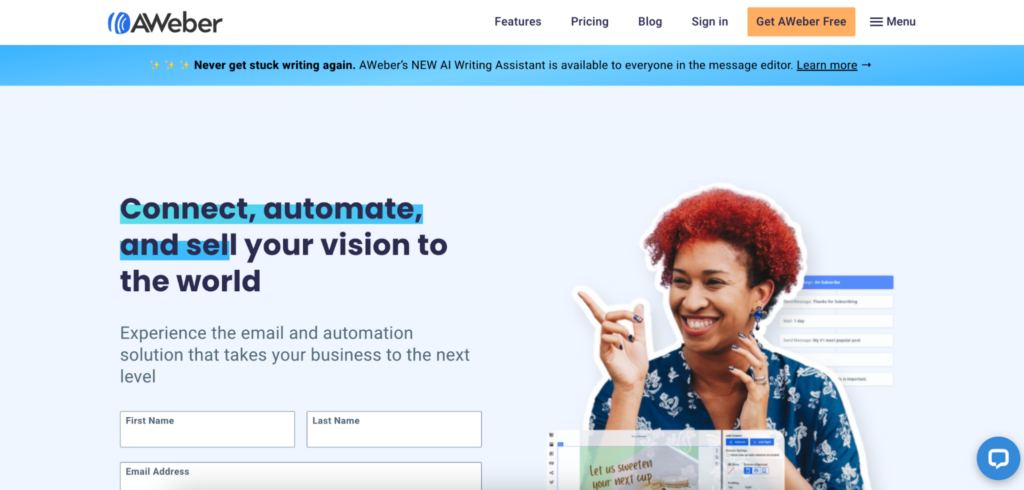
AWeber allows you to create visually catchy emails with its many templates and integration with Canva, an easy-to-use graphic design platform. With AWeber, you’ll have access to thousands of high-quality stock images that can make your email campaigns more appealing. Additionally, AWeber’s segmentation and tagging features allow you to target specific groups of subscribers based on their interests, behavior, or preferences.
Pricing: AWeber offers a free basic plan, although the most popular one starts at $20 per month.
Pros of using AWeber:
- Aweber has a strong reputation for high email deliverability rates. There are dedicated teams that work to maintain positive sender reputation and ensure that emails reach your subscribers’ inboxes effectively.
- Easily build campaign automations using a drag-and-drop editor.
- Integrates with numerous tools, including e-commerce platforms, content management systems, and customer relationship management systems.
4. Campaign Monitor
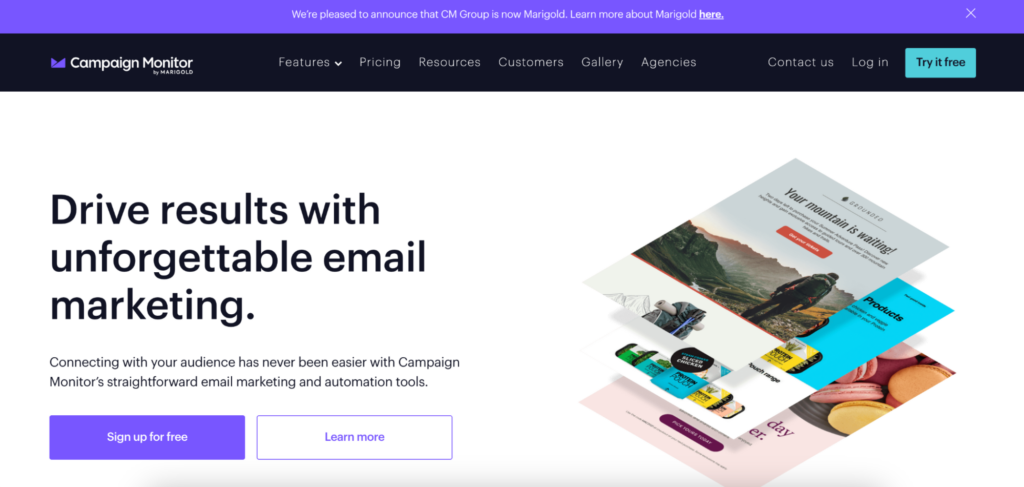
Campaign Monitor is a robust email marketing platform with features like email templates, automation workflows, A/B testing, and detailed reporting and analytics. The platform’s visual journey designer allows tour operators to create automated campaigns that guide customers through the booking process, leading to more conversions.
Campaign Monitor also makes it easy to customize your emails: You can input your website URL to automatically import your brand colors and logo into the design. The platform allows you to connect with guests via SMS messaging, combining the two channels your customers use most.
Pricing: Campaign Monitor offers a free library of email templates. Plans with more advanced features start at $9 per month.
Pros of using Campaign Monitor:
- You can highly personalize emails by displaying different content blocks within an email based on subscriber data or segmentation.
- Collaboration features allow multiple team members to work on email campaigns together.
- You’ll have access to in-depth analytics and reporting features, allowing you to track track key metrics to gauge the success of your campaigns.
5. Brevo (formerly SendinBlue)
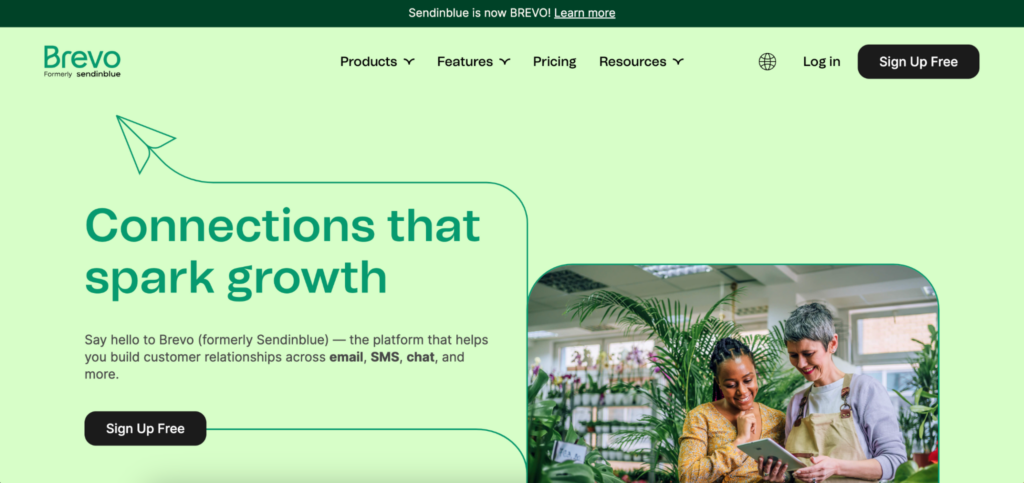
Brevo, formerly SendinBlue, is a platform that offers email marketing, SMS marketing, and live chat capabilities. The platform has CRM features that allow you to track all your email-generated bookings and understand which campaigns are generating the most revenue. Beyond email communication, you can also send targeted SMS messages to customers who have opted-in to receive texts. There’s a free plan, which makes it a great option for new and smaller operators.
Pricing: Brevo offers a variety of different plans depending on what your company is looking for. There are free plans available for the platform’s marketing, sales, and transaction email services. Meanwhile, the most popular business plan costs $65 per month.
Pros of using Brevo:
- The free plan allows operators to get to know the software before investing in more advanced features.
- You can send emails, SMS, WhatsApp messages, and web push notifications from within the same platform.
- Email support is available for the free plans, with phone and live chat support available for the Business plan.
6. GetResponse
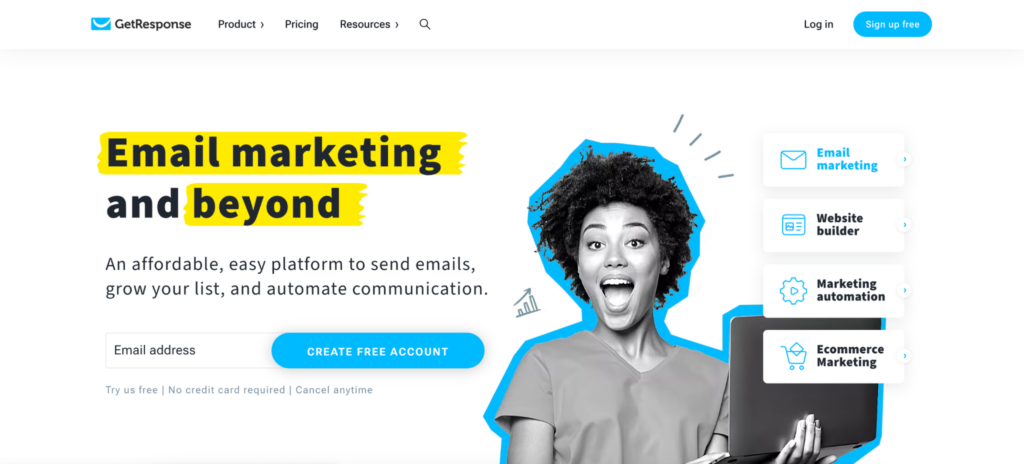
GetResponse is an email marketing platform with webinar hosting features that make it easy to promote and host online events. On the email marketing front, the platform offers automations, send-time optimizations, drag-and-drop email creator, and various newsletter templates. Plus, you’ll also be able to engage with your audience through web push notifications, SMS messaging, pop-ups, and live chats.
Pricing: You can try a free account and upgrade when you’re ready. Email marketing plans start at $19 per month.
Pros of using GetResponse:
- Built-in conversion funnels make it easier to create complete marketing funnels, including landing pages, webinars, and sales funnels.
- GetResponse has a robust webinar platform, allowing you to host webinars directly within the platform.
- The user-friendly landing page editor allows you to customize your landing pages without additional coding or design skills.
How to build your email list
Before you start reaping the benefits of email marketing, you need to build an email list. This can seem like a daunting task for many operators, especially when you’re first starting.
Here, we’ll break down nine tactics to help you attract the right email subscribers.
1. Add a sign-up form on your website
Encourage your website visitors to join your mailing list with an easy-to-spot sign-up form located on your homepage, a sidebar, or both. You might also create a pop-up form that’s triggered after a specific browsing time or when a visitor goes to exit your page.
The sign-up form should give users an idea of what to expect after signing up. HeliNY, for example, tells users they will receive “exclusive news about deals” when they sign up for the helicopter tour operator’s newsletter.
2. Create a lead magnet
One of the most effective ways to entice customers to subscribe to your email list is to offer them an incentive. This could be a discount on their first purchase, a free eBook, a free trial of your services, or anything else that your audience would find valuable. When creating your incentive, make sure it aligns with your brand and the interests of your target audience.
3. Promote your email list on social media
Social media is a powerful tool for engaging with your audience. Your followers will likely be a range of past customers and future guests who are curious about your tours. This is a great audience for your email list because:
- You can build loyalty with past customers and encourage them to visit you again
- You can reach potential customers off social media, making them more familiar with your brand
- You can offer incentives via email that persuade curious followers to make a booking
You can create a post specifically about your email list, include a call-to-action in your social media bios, or run a social media ad promoting the incentive you came up with earlier.
4. Experiment with giveaways and contests
A giveaway or contest can also be a great way to generate buzz around your brand. People love the chance to win something, so offer a prize that’s relevant to your brand and audience. For example, you can encourage your social media followers to sign up for your newsletter for a chance to win a free tour.
The downside of a giveaway is that you might attract an influx of low-value subscribers who aren’t interested in reading your newsletter. These new contacts unsubscribe as soon as they giveaway is over.
Once the giveaway is over, focus on engaging with the subscribers who showed genuine interest in your brand. Build a relationship with them through personalized follow-up emails, exclusive content, or special offers. This helps foster a sense of connection and encourages them to remain engaged with your brand.
5. Leverage your existing customer base
Your existing customers are already familiar with your brand and have shown an interest in your tours or attraction. Leverage this by offering them exclusive content or discounts if they sign up for your email list.
Another option is to have an opt-in checklist right on your booking page. This way, customers can easily subscribe to your email list as soon as they make a booking.
6. Partner with local businesses or influencers
Look for businesses or influencers in your industry or city with a similar target audience. Offer to promote their brand to your email list in exchange for them promoting your email list to their audience.
You can also partner with a local business to run a joint social media giveaway. Rather than asking followers to join just one email list, you’ll ask them to join both. In exchange, you and the local business or influencer will offer two separate gifts to the winner of the giveaway.
7. Pop-ups
Pop-ups might be a bit controversial, but they can be effective in building an email list. Website popup builder Getsitecontrol found that mobile popups convert an average of 6.6% of visitors, while desktop popups convert about 3.8%.
But make sure the pop-up is not intrusive and can be easily closed. You can experiment with different designs and triggers to see what works best for your audience. For instance, you might trigger a newsletter pop-up after someone spends a minute browsing your site.
8. Include it in your email signature
Upon making a booking, your guests will receive several different emails, including the booking confirmation, reminders, and updates.
Each one should contain an email signature — an often-overlooked opportunity to promote your email list. Include a call-to-action and a link to your sign-up page in your email signature. Now, every email you send is an opportunity to grow your list.
9. Run paid social media ads
Paid social media ads can help you reach a targeted audience that would be interested in joining your email list. Facebook and Instagram ads, specifically, can help you reach potential customers based on location, age, and gender, among other demographics. You can even narrow down your audience by interests and behaviors — such as “frequent travelers” or people who “like” a particular activity like kayaking.
What types of emails should you send?
- Educational emails: Provide value to your subscribers by sharing information about your destination or industry. For example, you could send an email with tips on how to prepare for a trip to your particular location. If you’re a scuba diving company, you could send an email with information about the species found in your region. Educational emails can help establish you as an expert in your field and build trust with your subscribers.
- Promotional emails: These are designed to promote a specific tour, activity, or service. For example, you could send an email promoting a new tour package or offering a discount on a particular experience. Promotional emails can be a great way to drive sales and incentivize your subscribers to book a trip with you.
- Inspirational emails: Inspire and motivate your subscribers to travel or live an unforgettable experience with you. For example, you could send an email featuring stunning photos of your particular destination, or one highlighting the unique experiences your company offers. Inspirational emails can help build excitement and anticipation for your experiences, which can ultimately lead to more bookings.
- Customer reviews and social proof: Customer feedback is a powerful tool in convincing potential customers to book with you. If you send an email featuring a glowing review and photos from a recent tour, your subscribers will be able to imagine themselves having the same experience. Customer testimonials can help build trust and credibility with your audience, which can ultimately lead to more bookings.
- Business updates: Keep your subscribers in the know about changes or updates to your business. Make them feel like they’re a part of your community, so much so that you’re sharing updates about the inner workings of your business with them. For example, you could send an email announcing that you’ve hired a new tour guide or expanded to a new location.
- Share industry news and trends: Similar to educational emails, sharing industry news and trends will further establish you as an expert in your field. Plus, it’ll keep your subscribers informed about the latest happenings in your industry.
- Promote special events: You’ll certainly want to promote your holiday or seasonal offers via email. Promotional emails can incentivize an influx of bookings and keep your subscribers engaged year-round. For example, you could send an email offering a discount on a particular tour package for a limited time to drive more bookings during your slow season.
Email Frequency
Email frequency is an important topic to consider when building your email marketing strategy. While you should refrain from overwhelming your subscribers with too many emails, you also don’t want them to never hear from you again after signing up.
According to Campaign Monitor, newsletters should be sent no more than twice a week. If that feels like too much — it takes a lot of time and effort to write eight emails per month — consider a monthly update instead. Campaign Monitor found that businesses should email their customers at least once a month.
Another option is to ask your customers how often they want to hear from you. You can poll them after they sign up, and then segment your audience accordingly.
Email CTAs
Every email you send should have a call-to-action (CTA) that encourages subscribers to take the next step, such as book a tour, sign up for a newsletter, or follow a social media page, among other things.
Yet one of the most common misconceptions about CTAs is that more is better. When in fact, the opposite is true. The fewer CTAs in an email, the more likely someone is to take the desired action.
Too many CTAs can overwhelm readers and cause them to take no action at all. The more options the reader is presented with — like “sign up for our newsletter,” “leave us a review,” or “follow us on social media” — the more difficult it becomes for them to make a decision.
Limiting the number of CTAs in an email makes it easier for the subscriber to focus on the one action you want them to take.
Monitoring key email marketing metrics
1. Setting email marketing goals
The first step in monitoring your email marketing strategy is to set clear campaign goals. Establishing specific objectives for your campaigns can help you define which metrics matter most. For instance, your goals for one campaign may be to increase bookings, while for another, it might be to improve customer engagement. By setting specific goals for each campaign, you’ll know how to best measure their success.
2. Open rates
The email open rate refers to the percentage of people who opened your email. This metric can tell you whether the email’s subject line is working or not. A high open rate indicates that the subject line motivated the recipient to open the email. On the other hand, a low open rate may suggest that the subject line did not capture their attention — or that the email was caught in a spam filter.
However, Apple’s new Mail Privacy Protection (MPP) allows users of the Apple Mail app or desktop email app to hide information about when, where, and how they open emails. This has made it more difficult to get accurate data on email open rates.
In fact, the new privacy laws can inflate your open rates artificially. It’s important to closely monitor the metrics below, which will provide you with a more realistic representation of user interaction with your campaigns.
3. Click-through rates
Click-through rates refer to the percentage of recipients who clicked on a link within your email. This is an important metric to track when you’re trying to drive bookings or traffic back to your website. It will tell you how many people have actually clicked on your desired CTA. It helps indicate how engaging and relevant the email’s content was to the recipient. A high click-through rate indicates that the content in your email resonated with your audience.
4. Reply rate
Reply rate refers to the percentage of recipients who replied to an email campaign. A high reply rate indicates that your audience is interested in your tour packages or services and is likely to take further action, such as booking a tour or reaching out to your sales team.
5. Revenue generated from email
This metric measures the amount of revenue generated as a direct result of your email campaigns. This includes sales that were made as a direct result of an email campaign, as well as any revenue generated from repeat bookings or referrals. For a tour operator, this metric is crucial because it helps you understand the ROI of your email marketing efforts and the impact it has on your business.
6. Unsubscribe rates
Unsubscribe rates refer to the percentage of recipients who unsubscribe from your list after a particular email campaign. If a lot of your contacts unsubscribe from your email list every time you send an email, you may want to revisit your email strategy. It’s likely that the content isn’t resonating with your target audience. In response, you can try A/B testing the content, tours featured, and types of emails sent to find what appeals most to them.
7. Referral traffic to your website from email
Measuring the number of visitors who came to your website from your email campaigns helps you measure audience engagement. When a customer is interested enough in your tours or promotional offers, they will kick onto your website to learn more. High referral traffic indicates that you’re reaching the right audience at the right time.
8. Social shares from email
This metric measures the number of social shares that your email campaigns have generated on platforms like Facebook, Twitter, and LinkedIn. Again, this metric can help you understand the level of engagement your email campaigns generate beyond just the email platform. Social shares are exciting because it means that customers find your content so valuable that they want to share it with others. And this can generate more leads for future bookings.
***
By now, you should have a good understanding of how to build an email list. As you’re crafting your campaigns, make sure the email content is relevant and engaging, and gives your customers the best next action to take.
With the right email marketing platform and a solid strategy in place, you can build long-lasting relationships with your guests, increase bookings, and ultimately, drive revenue for your tour operator business.




